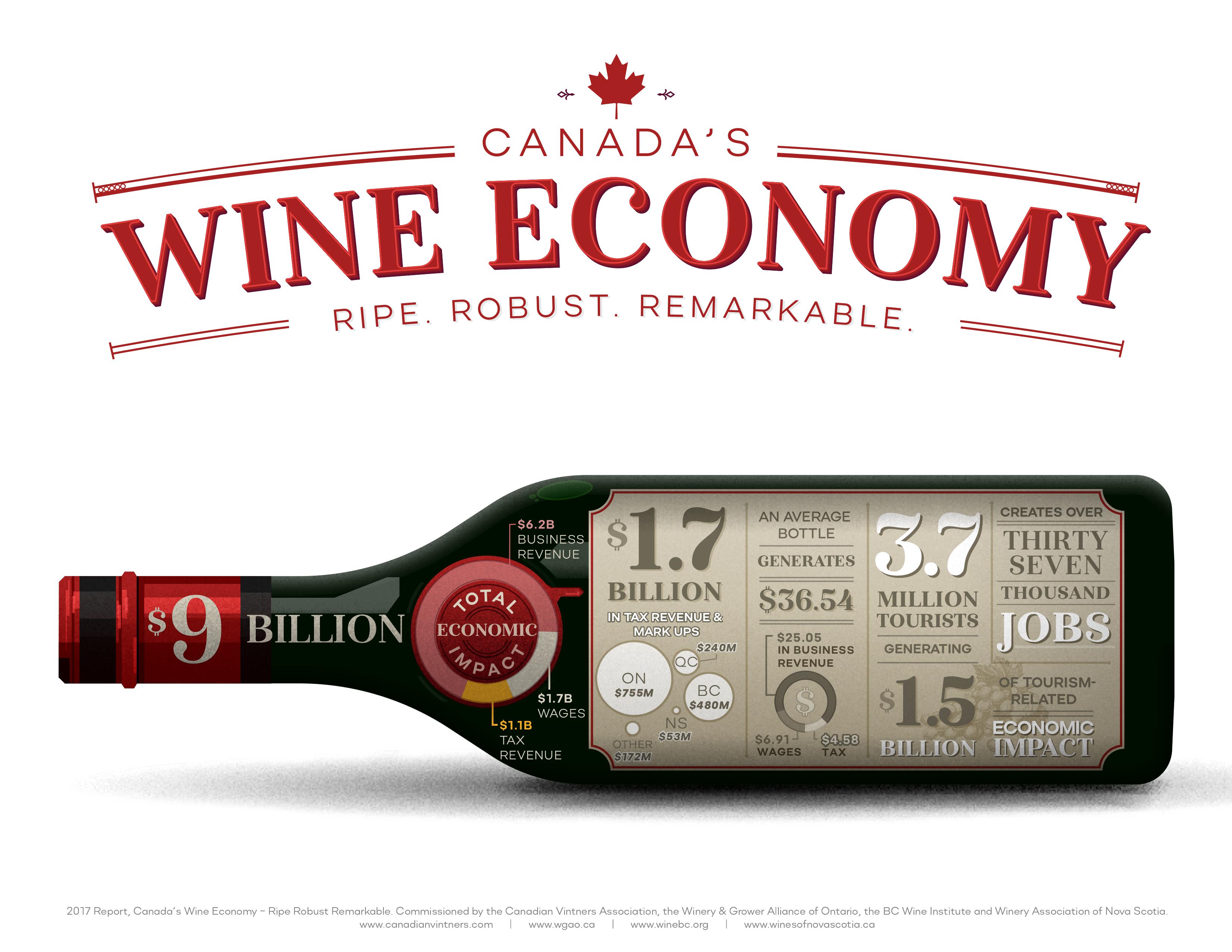Wine in Canada: #Cdnwine is a growing economic driver
A report released by the Canadian Vintner’s Association (CVA) last month is telling a story of the economic impact Canada’s growing wine industry sector is having. In a phrase, “a whole bunch”. The CVA’s study tells a tale of growing volume, revenues, and impact on tourism and export markets (which are still comparatively small). Oh yeah, and it generates a lot of liquor taxes for good things like health care and transportation.
To access the various reports, visit the following link. The CVA’s release is embedded below.
~~
Together with the All-Party Parliamentary Canadian Wine Caucus, the Canadian Vintners Association (CVA) and its partners are happy to announce the results of a research study conducted on the Canadian wine and grape industry, which reveals that the economic impact of the Canadian Wine industry is up 33% from $6.8 billion to $9 billion over the period 2011-2015.
“I would like to commend the Canadian wine industry on demonstrating such positive economic growth, significant in many of Canada’s wine growing regions.” said Central Okanagan-Similkameen-Nicola MP and Co-chair of the Parliamentary Wine Caucus, Dan Albas.
Commissioned by the Canadian Vintners Association, the Winery & Grower Alliance of Ontario, the British Columbia Wine Institute and the Winery Association of Nova Scotia, the report Canada’s Wine Economy – Ripe Robust Remarkable confirms the wine industry has become a large and significant contributor to the overall Canadian economy, especially in Ontario, British Columbia, Quebec and Nova Scotia.
“The Canadian wine industry is an increasingly significant contributor to our national economy,” said CVA President and CEO Dan Paszkowski. “Our 671 wineries, largely small, family-owned businesses, create jobs, pay significant taxes, and boost regional, provincial and national economies alike,” he added.
Canadian winemakers support a broad network of related industries in rural and regional centres across Canada through significant investments, long-term jobs and market opportunities in rural communities.
“The wine and grape industry is a Canadian success story. Not only does the sector employ over 37,000 Canadians, but the diversity of the jobs created from this industry is remarkable. Ranging from tourism and retail, to marketing, laboratory research, and farming, this sector welcomes Canadians from a range of backgrounds and talents,” said MP for Niagara Centre and Co-chair of the Parliamentary Wine Caucus, Vance Badawey. “Building on the successes to date, I look forward to working alongside all industry stakeholders as we continue to grow this exceptional industry,” he added.
Wine consumption in Canada continues to grow as many Canadians are reaching for a glass of wine over spirits or beer. With Canadian wines presently representing only 30% of total wine sales across the country and imported wine at 70%, there is enormous potential for Canadian wine sales growth which would benefit the entire national economy.
“Every dollar invested in the Canadian wine economy stimulates more jobs, more revenue and more taxes,” says Paszkowski. “We contributed $9 billion to the national economy in 2015 or $1 million every hour, which is 33% more than in 2011.”
The independent study was conducted by Frank, Rimerman + Co., a leading international accounting and research firm in the wine industry, which has conducted similar studies for other winemaking regions around the world.
Key Findings:
- Canadian wine industry production has an annual national economic impact of $9 billion
- An average bottle of wine sold in Canada there is $36.54 of domestic economic impact generated in the country.
- The Ontario wine and grape industry generates $4.4 billion in economic impact, British Columbia $2.8 billion, Quebec $1.1 billion and $218 million in Nova Scotia.
- The wine and grape industry is responsible for more than 37,000 jobs in Canada from manufacturing, agriculture, tourism, transportation, research, restaurants and retail.
- Wine-related tourism welcomes more than 3.7 million visitors each year, generating more than $1.5 billion annually in tourism revenue and employment.
- The wine industry generates $1.7 billion in federal and provincial tax revenue and liquor board mark up.
- For every $1 spent on Canadian wine sold in Canada, $3.42 in Gross Domestic Product (GDP) is generated across the country.
Complete findings of the study can be found in the research report, Canada’s Wine Economy – Ripe Robust Remarkable. www.canadianvintners.com
About the Canadian Vintners Association (CVA)
CVA is the national voice of the Canadian Wine Industry representing more than 90% of annual wine production. CVA members are engaged in the entire wine value chain from grape growing, farm management, grape harvesting, research, wine production, bottling, retail sales and tourism. www.canadianvintners.com
About the Winery & Grower Alliance of Ontario (WGAO)
WGAO is a trade association representing leading wineries and grape growers in the province. WGAO members represent some 85% of the wine produced in Ontario and purchase 85% of the grapes grown by independent grape growers. www.wgao.ca
About the British Columbia Wine Institute (BCWI)
Since 1990, BCWI has played a pivotal role in taking BC’s wine industry from a vision to an internationally recognized region producing premium wines and providing quality wine tourism experiences. Representing 158 member wineries throughout the province, the BCWI supports and markets the Wines of British Columbia (BC VQA), which gives consumers assurance they are buying a wine that is 100% made in BC. www.winebc.com
About the Winery Association of Nova Scotia (WANS)
WANS was formed in 2002 to represent the interests of wine producers in Nova Scotia, to serve as a voice for local industry and to promote the growth and development of Nova Scotia wines. www.winesofnovascotia.ca

